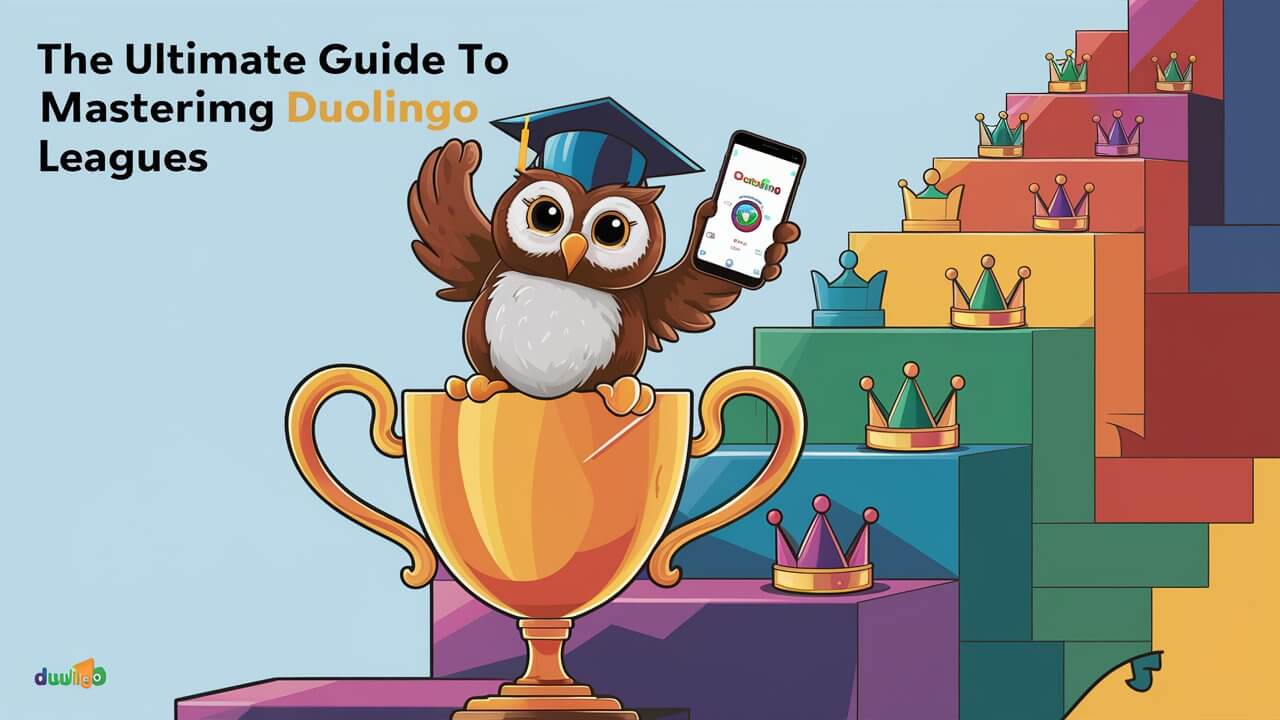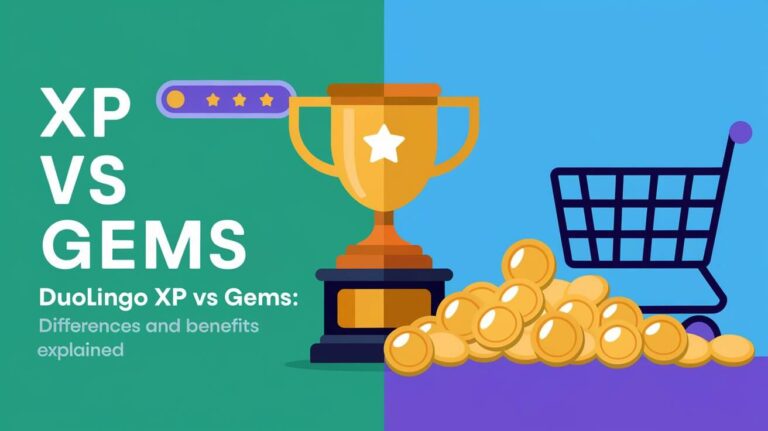Are you obsessed with climbing up the Duolingo leaderboards? Maybe you dream of reaching the elusive Diamond League and competing in the intense Diamond Tournament. Or perhaps the league system just stresses you out and feels like a distraction from actual language learning.
The Duolingo league system adds an engaging but often confusing competitive element to the language learning experience.
This guide explains how Duolingo’s leagues work, strategies for improving your ranking, and whether focusing intensely on leagues is productive. It discusses mastering Duolingo’s leagues while keeping your language goals in perspective.
Understanding the Duolingo League System
Before we get into strategies and tips, let’s cover the basics of how Duolingo’s leagues work. This competitive system adds gamification by ranking users based on their weekly XP earnings across all the languages they are studying.
The Different League Levels Explained
There are 10 different league levels that users can progress through:
- Bronze
- Silver
- Gold
- Sapphire
- Ruby
- Emerald
- Amethyst
- Pearl
- Obsidian
- Diamond
Each week, the leaderboards reset and you are assigned a new league based on your XP earnings from the previous week. Your goal is to finish ranked in the top positions of your current league to advance to the next higher level the following week.
For example, if you finish in the top 20 of the Bronze league, you’ll move up to Silver for the next weekly competition. However, if you place in the bottom ranks like 24th-30th, you’ll be demoted down to a lower league tier.
The top finishers in each league also earn rewards in the form of bonus Gems (Duolingo’s virtual currency) based on their placement. Historically, these Gem rewards increased as you climbed into the higher league levels.
How Users Are Grouped Into Leagues
One aspect that confuses many Duolingo users is how the leagues are populated each week with groups of competitors. It’s not just a free-for-all with random users from across the globe.
Instead, Duolingo groups users into their weekly leagues based on a few key factors:
- Time zone – Users are clustered into leagues with others in the same or adjacent time zones to align the weekly start/end times.
- Recent activity level – Your league-mates will have similar XP earning levels over the previous week. If you’ve been practicing intensely, you’ll compete against others also earning high XP totals.
- Device used – Whether you use the Duolingo app or website appears to factor in as well, with users being segmented based on platform.
There are typically around 30 users placed into each newly formed league when it opens every Monday morning, though sizes can fluctuate if you join a league later in the week.
How to Earn Maximum XP and Boost Your Ranking
While knowledge and comprehension should be the priorities, the unfortunate reality is that maximizing XP earnings is key if you want to progress through Duolingo’s league system and achieve prestigious ranks like Diamond.
Understanding How XP is Awarded
XP is Duolingo’s point system, awarded for completing various learning activities within the app and website. Some key ways to earn XP include:
- Completing lessons (10 XP per lesson, plus periodic bonus XP awarded)
- Practice sessions (review learning from previous lessons)
- Stories and Audios (mini reading/listening activities)
- Ramp Up challenges (timed practice sessions awarding up to 40 XP)
There are also double XP boosts that savvy leaderboard competitors use strategically. These allow you to double your XP earnings for a set period, though the duration is limited.
Many high-ranking league users also employ “XP farming” tactics like repeatedly revisiting easier lessons from early in their course to rack up XP quickly during the double XP periods.
Optimizing Your Study Schedule
Beyond understanding how to earn XP most efficiently, successful Duolingo league competitors also optimize their study schedules for maximum impact.
For example, it’s ideal to practice during peak times when your league-mates are likely less active—like early morning, late evening, etc. That way, your XP earnings will stand out more against the competition each day.
Setting a specific daily or weekly XP goal, and tracking your progress against others on the leaderboard, can also help motivate you to stay consistent with practicing regularly.
And especially in the higher leagues, it’s wise to adjust your effort level based on how intensely competitive your current league group seems to be. No need to overexert if you can likely coast to a top position that week with a reasonable amount of effort.
Strategies for the Higher Leagues
While advancing through the initial Bronze, Silver, and Gold leagues can be relatively straightforward, the competition intensifies significantly as you reach the Ruby, Emerald, and Diamond levels. These prestigious ranks require truly distinguished XP earnings to attain.
Preparing to Advance to Ruby, Emerald, Diamond
What kind of XP totals are we talking about? While it varies week-to-week based on your specific set of league-mates, you can generally expect to need:
Ruby League: Around 17,500 XP Emerald League: 19,000 XP Diamond League: 100,000 XP
Yep, those are big numbers! Reaching the Diamond League is a major milestone that means you were one of the top XP earners across all of Duolingo that week.
Suppose you want to make it to these upper echelons consistently. In that case, you’ll likely need to optimize your routine with tactics like double XP boosts, interval training with timed practice sessions, and lots of repeated lessons to accumulate XP quickly.
You’ll also need to find the right balance of investing significant but sustainable effort. Going too hard and burning yourself out is counterproductive.
Tips for Surviving in the Diamond League
Even after the major accomplishment of first reaching the Diamond, you can’t rest on your laurels. The Obsidian and Diamond leagues represent the absolute highest tiers of Duolingo competition.
To avoid getting demoted back out of Diamond on any given week, plan on needing to maintain jaw-dropping 30,000+ XP totals. The ultra-competitive users at this level are maxing out double XP boosts daily, squeezing every last point out of practice sessions and stories, and likely using exploitative XP farming tactics as well.
That said, try not to get demotivated if you can’t keep up that furious pace week after week. The Diamond League attracts Duolingo’s most hardcore leaderboard grinders, but simply reaching it once is an immense achievement worth celebrating!
An Inside Look at the Diamond Tournament
For those who do manage to secure a top-10 finish in the Diamond League during any given week, they qualify for an even more elite sub-competition: The Diamond Tournament.
This intense, multi-week tournament has three phases:
- Quarterfinals
- Semifinals
- Finals
In each round, users face off in a smaller league, with the top finishers advancing to subsequent rounds and the rest being relegated back to the regular Diamond league.
Only 10 users make it to the Finals, competing for invaluable rewards and recognition. These include:
- Substantial Gem prizes (numbering in the thousands)
- Special profile banners and achievements
- Global prestige for finishing atop Duolingo’s most elite competition
While most may never reach the level of Diamond Tournament competition, it provides aspirational goals for the true diehards of Duolingo’s league system.
Is It Worth Focusing Intensely on Duolingo Leagues?
With all the strategy, effort and competition around leagues laid out, you may be asking yourself: Is this really worth it if my main goal is learning a new language?
The competitive mindset that leagues inspire can certainly drive active practice and steady progress for many learners. However, an excessive fixation on chasing XP and climbing leaderboards rather than prioritizing actual comprehension can ultimately hold you back from reaching your full language potential.
Potential Downsides of Being Too Competitive
It’s important to be aware of some key pitfalls and downsides that an overly intense focus on leagues can lead to:
Burnout and frustration: Spending hours each day obsessively refreshing leaderboards and grinding away at lessons can quickly lead to mental fatigue and drain your motivation over time.
Prioritizing XP over comprehension: When the goal becomes earning as many points as possible, it’s easy to slip into bad habits like rushing through lessons without fully absorbing the material. You may find yourself mindlessly repeating basic activities you’ve already mastered rather than pushing into more difficult concepts that would deepen your skills. Ultimately, this undermines your actual language learning progress.
Exploiting “achen” shortcuts: In the relentless pursuit of XP, some overly competitive users resort to exploits and shortcuts that provide a ton of points without any real learning taking place. Repeating simple speaking exercises with gibberish responses or using keyboard smashing to”hack” practice sessions may boost your league ranking, but you’re just cheating yourself.
Finding the Right Balance
While the negatives above are worth keeping in mind, the gamified league system can actually provide positive benefits for many Duolingo learners when approached with a balanced, sustainable mindset. The key is using the leaderboards as one motivational tool in your toolkit rather than obsessing over them.
Leagues can inspire you to establish a consistent daily practice routine and give you motivating goals to work toward like advancing to a new league level. There’s also an undeniable sense of community and camaraderie when you’re collectively pursuing those milestones alongside your current league-mates.
The ideal approach is to strive for steady upward progress through the different league tiers over time, while celebrating each new level as an achievement.. Then reset your priorities for that week – your main focus should be on maximizing comprehension through quality practice rather than grinding for an XP total.
If you do find yourself in a top position toward the end of a given week, you can strategically boost your effort level over those final days in order to secure advancement to the next league. But don’t burn yourself out doing so week after week.
Conclusion
The Duolingo league system adds an undeniably engaging and motivating dimension to the language learning experience that has clearly resonated with millions of users worldwide. While the competitive aspects of chasing league promotions and XP earnings can inspire misplaced priorities, approaching the leagues with a balanced, sustainable mindset is ideal.
Celebrate your achievements at each new league level you reach, but don’t lose sight of your core goal: Developing true mastery of your target language through quality practice, comprehension of core concepts, and consistent routine. With the right mix of steadily pushing yourself to advance through the leagues while keeping your long-term learning objectives as the top priority, you can make consistent upward progress through the ranks over time.
The most important factor is persistently showing up to engage with your target language through Duolingo and supplemental resources. Avoid the temptation to obsess over XP farming or leaderboard positioning. Instead, remain focused on absorbing vocabulary, grammar rules, and speaking/listening skills through quality practice. The leagues can provide a motivating backdrop to that core practice – but should never completely monopolize your efforts at the expense of actual learning.







